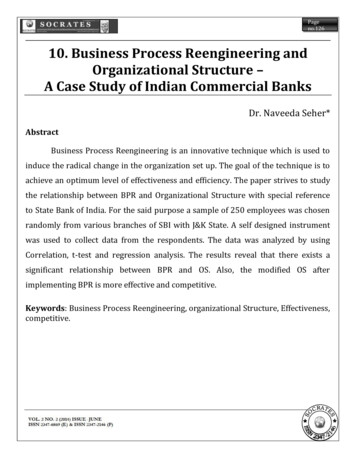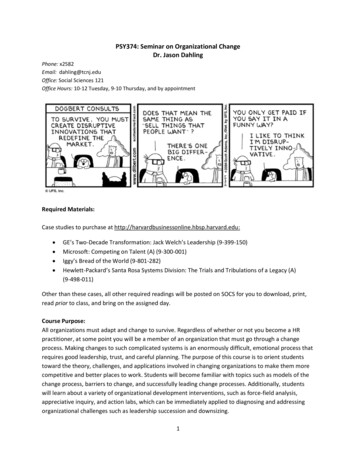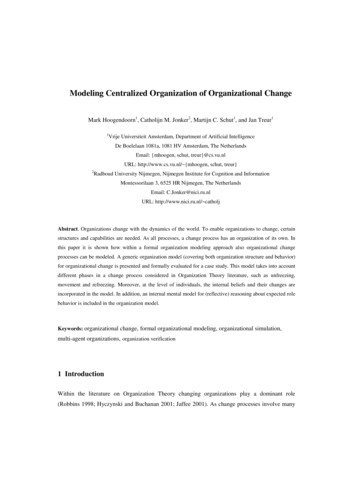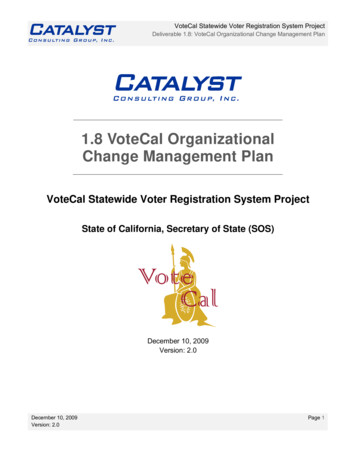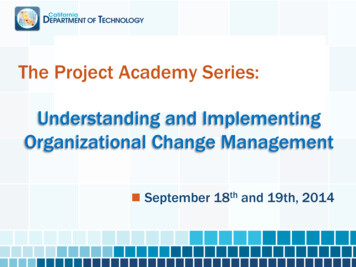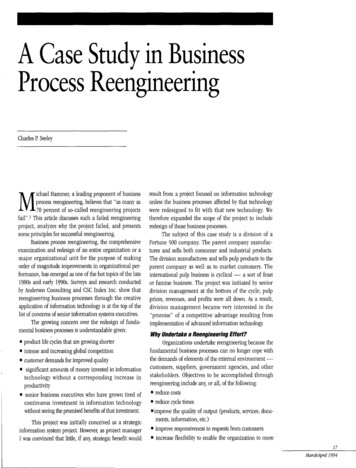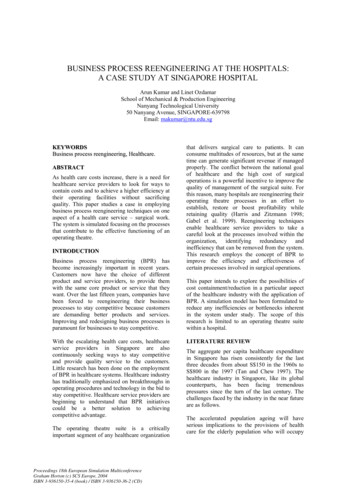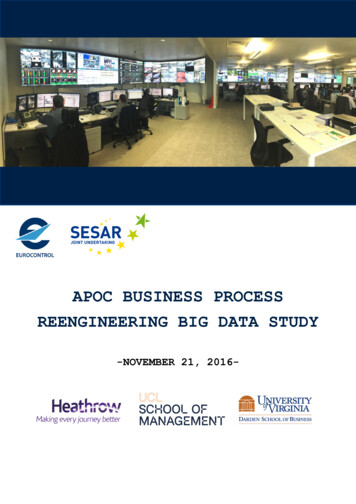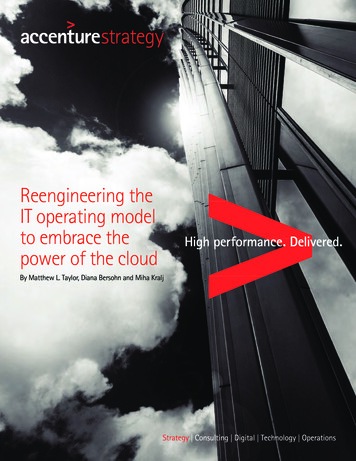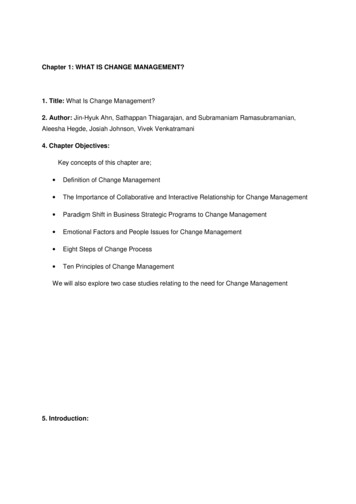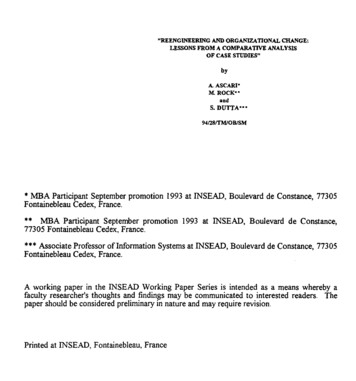
Transcription
"REENGINEERING AND ORGANIZATIONAL CHANGE:LESSONS FROM A COMPARATIVE ANALYSISOF CASE STUDIES"byA. ASCARI*M ROCK"andS. DUTTA".94/2S/TM/OB/SM* MBA Participant September promotion 1993 at INSEAD, Boulevard de Constance, 77305Fontainebleau Cedex, France.** MBA Participant September promotion 1993 at INSEAD, Boulevard de Constance,77305 Fontainebleau Cedex, France.*** Associate Professor of Information Systems at INSEAD, Boulevard de Constance, 77305Fontainebleau Cedex, France.A working paper in the INSEAD Working Paper Series is intended as a means whereby afaculty researcher's thoughts and findings may be communicated to interested readers. Thepaper should be considered preliminary in nature and may require revision.Printed at INSEAD, Fontainebleau, France
Alessio AscariMelinda RockMBA Participants 1993-1994INSEADProf. Soumitra DuttaTechnology Management AreaINSEAD
Table of ContentsAbstract1.Introduction2.Objective & Approach of Study3.Framework4. Assumptions and Scope5. Summary of Successful Elements and Challenges/Pitfalls6.General ConclusionsAppendixHallmarkPhillips 66Singapore AirlinesFrito LayKodakQuantumWal-MartBell AtlanticDaimler Benz HoldingNissanRank Xerox, UKReutersBritish AirwaysCapital Holding CorporationTrustees Savings Bank (TSB)Taco 031323334
AbstractBusiness Process Reengineering is fast becoming the terminology of manycompanies' efforts to reexamine their businesses to improve competitiveness.As such it is also the object of numerous reports and studies which defineframeworks and suggest methodologies for organizational change. This reportcompares and contrasts several companies' efforts in implementingreengineering/change programmes. The successful elements of various changeprogrammes as well as some of the challenges and "pitfalls" of the companies'efforts are emphasised.1
1. IntroductionIn today's business environment, customer needs evolve at an extremely quickpace due to the increased mobility of resources and to the development ofmedia and technology. A constant challenge faced by today's management ischange. In such a context, restructuring alone is proving increasinglyinsufficient in achieving and sustaining the improvements needed to remaincompetitive.As organisations strive to be more competitive in today's challenging businessenvironment, more of them are taking a radical look at how and what makesthem successful. Some refer to this type of effort as Business ProcessReengineering (henceforth referred to as BPR). As the phrase becomes morewell-known, we see more definitions of it and it is useful to mention some ofthem to facilitate setting the context for this work:"Reengineering is the fundamental rethinking and radical redesign ofbusiness processes to achieve dramatic improvements in critical,contemporary measures of performance, such as cost, quality, service,and speed.'"Reengineering has been simply defined as the analysis and redesign ofbusiness and manufacturing processes to eliminate that which adds novalue" 2"Reengineering is a radically new process of organisational change thatmany companies are using to renew their commitment to customerservice"3Some common aspects can be identified in most definitions of reengineering.For one, there is an emphasis on rethinking different aspects of the businessand existing work practices:"It isn't about fixing anything, [it] means starting all over, starting fromscratch"4Much of the motivation for this rethinking seems to arise from observationsthat many current business practices are outdated and are no longer eithersuited for today's competitive situation or matched to the capabilities offeredby current technology:1 Hammer M. and Champy, J, Reengineering the Corporation: A Manifesto for Business Revolution,Harper Business, 1993.2 Parker, K., "Reengineering the Auto Industry," Manufacturing Systems January, 1993.3Janson, "How Reengineering Transforms Organisations to Satisfy Customers," NationalProductivity Review, Winter 1992-93, pp. 45-53.4 Hammer M. and Champy, op. cit.2
"The problem appears to be.developed systems of production that wereremarkably successful in their time but are no longer suited to a changedworld"5Also central to reengineering is an emphasis on processes. BPR proceeds underthe assumption that a business can be defined as a set of inter-related processesthat are logically and continuously evolving to satisfy a set of commoncustomer oriented objectives. A process from this point of view could bedefined as ". a sequence of activities that fulfils the needs of an internal or externalcustomer"6 ". a collection of activities that takes one or more kinds of input andcreates an output that is of value to the customer"7In addition, today BPR itself, is becoming a process, an ongoing effort ofanalysing and radically redefining the key processes of a company. Regardless ofhow one views BPR and its components, its ultimate goal is to enablecompanies to achieve radical performance gains. The objective(s) ofperformance gains may differ from company to company - cost for some, speedfor others and quality for yet others.2. Objective & Approach of StudyBPR has generated significant controversy in the literature. Some such asDrucker 8 have advocated that it is: ".new and it has to be done", while othershave been quick in dismissing it as a passing management fad. Some' havetaken the middle ground and have identified aspects of BPR which are newand innovative and other aspects which are "old" and have been seen before.The objective of this study is not to debate whether BPR is new or old, butrather to analyse approaches, methodologies, tools and other supports thathave been used in various BPR projects. By studying their similarities anddifferences, we hope to better understand the advantages and disadvantagesand hence applicability of certain approaches to particular real contexts.The approach taken and reported in this paper was to:5Keith Grint, "Reengineering History: An Analysis of Business Process Reengineering," AngloAmerican Insurance Company Limited, October, 1993.6Harrison, D.B. and Pratt, M.D., "A Methodology for Reengineering Businesses," PlanningReview, March-April 1993, pp. 6-11.7Hammer and Champy, op. cit.8Peter Drucker on the cover of Hammer and Champy's book.9 M.J. Earl, The Old and the New of Business Process Redesign, Working paper # CRIMWP94/6, London Business School, 1994.3
1. Examine the prevalent frameworks in use today and choose/develop onewithin which to analyse and characterise case studies of some companies'recently completed BPR projects,2. Analyse according to the framework several case studies to learn thevarious existing problems, desired goals, approaches, methodologies, andtools applied,3. Summarise the findings of the analysis according to similarities anddifferences among the companies, their problems, and their efforts in orderto draw conclusions.3. FrameworkMany frameworks to analyse businesses and define change programmes havebeen developed, mostly by authors of management theory and within themajor management consultancies. Two representative frameworks are the 7-Smodel and the Business Integration model.Developed in the late 1970s, the 7-S model lo emphasizes the importance ofachieving consistency and balance between the seven descriptive elements(7S's) for understanding the dynamics of organisational change and developinggoals for a change program. The seven S's are: Strategy: a coherent set of actions aimed at gaining a sustainablecompetitive advantage (and as such the approach to allocating resources). Skills: distinctive capabilities possessed by the organisation as a whole asdistinct from those of an individual. Shared Values: ideas of what is right and desirable (in corporate and/orindividual beheavior) as well as fundamental principles and conceptswhich are typical of the organisation and common to most of its members. Structure: the organisation chart and related concepts that indicate whoreports to whom and how tasks are both divided up and integrated(reporting relations and management responsibilities). Systems: the processes and procedures through which things get done. Staff: the people in the organisation, considered in terms of corporatedemographics (not individual personalities), i.e., their skills and abilities. Style: the way managers collectively behave with respect to use of time,attention and symbolic actions.10 Pascale, R.T. and Athos, A.G.,McKinsey & Company4"The Art of Japanese Management", Simon & Schuster, 1981;
1. Examine the prevalent frameworks in use today and choose/develop onewithin which to analyse and characterise case studies of some companies'recently completed BPR projects,2. Analyse according to the framework several case studies to learn thevarious existing problems, desired goals, approaches, methodologies, andtools applied,3. Summarise the findings of the analysis according to similarities anddifferences among the companies, their problems, and their efforts in orderto draw conclusions.3. FrameworkMany frameworks to analyse businesses and define change programmes havebeen developed, mostly by authors of management theory and within themajor management consultancies. Two representative frameworks are the 7-Smodel and the Business Integration model.Developed in the late 1970s, the 7-S model lo emphasizes the importance ofachieving consistency and balance between the seven descriptive elements(7S's) for understanding the dynamics of organisational change and developinggoals for a change program. The seven S's are: Strategy: a coherent set of actions aimed at gaining a sustainablecompetitive advantage (and as such the approach to allocating resources). Skills: distinctive capabilities possessed by the organisation as a whole asdistinct from those of an individual. Shared Values: ideas of what is right and desirable (in corporate and/orindividual beheavior) as well as fundamental principles and conceptswhich are typical of the organisation and common to most of its members. Structure: the organisation chart and related concepts that indicate whoreports to whom and how tasks are both divided up and integrated(reporting relations and management responsibilities). Systems: the processes and procedures through which things get done. Staff: the people in the organisation, considered in terms of corporatedemographics (not individual personalities), i.e., their skills and abilities. Style: the way managers collectively behave with respect to use of time,attention and symbolic actions.10 Pascale, R.T. and Athos, A.G., "The Art of Japanese Managetnent", Simon & Schuster, 1981;McKinsey & Company4
The Business Integration Model 11 (see Figure 1) is built upon the principle thata consistent and comprehensive organizational change program should takeplace around the following four aspects of the organisation: Strategy: how the organisation plans to carry out its mission and objectivesboth from an external (customer-oriented) perspective as well as from aninternal resources viewpoint. Operations: how the organisation operates to achieve its objectives; theprocesses that support the strategic plans, the organisation structure and thetechnology engaged. Organisation: how the organisation is structured to effectively meet itsobjectives; who communicates with whom and how. Technology: how the organisation uses technology to support its strategy,operations and organisation both from a customer as well as an employeeperspective. Strategic Planning Buyer Values/Customer Focus Product/Market Strategy Financial Strategy Change Readiness Organisation Design Knowledge Transfer Technology Assimilation Business Process Improvement Logistics optimisation Facilities Planning Technology Assessment Information Technology Planning Systems Integration Computer Systems ManagementFigure 1: The Business Integration ModelOur objective in using a framework in this research was primarily: to facilitate consistent structuring and analysis of a set of very differentbusiness situations and change programmes, and to enable us to draw comparisons and conclusions among them.Building on the important aspects of the frameworks explored we adaptedthem to a structure that best serves our objectives, namely to emphasise: 1) thebusiness context at the start of the programme and the companies' goals at thattime, 2) the efforts undertaken and whether or not they were successful, and 3)the results obtained. Thus, the adopted framework (see Figure 2) classifies the11 Andersen Consulting5
change efforts under context, goals, successful elements, challenges/pitfalls andresults achieved. Within these classifications, successes and pitfalls are analysedin terms of culture, process, structure and technology.The context highlights external and internal characteristics of an organisation'sneed for change and the constraints it may face in so doing. External elementsinclude the economy, the industry, the competition, the marketplace, customerdemands, etc.; internal elements include historical progression of theorganisation, results of previous change efforts, cultural aspects, etc.The goals stated are those of the change program undertaken and are notnecessarily the organisation's high-level business goals. Many of them, in fact,lead to long term or continuous improvement of the firm but are beingconsidered in this report because of their importance to the changes beingdesigned and implemented.The successful elements and challenges/pitfalls of the various change programshave been examined according to a framework that differentiates: Culture: shared values and experiences and common goals that ". agroup learns over a period of time as that group solves its problems ofsurvival in an external environment and its problems of internalintegration";12 Processes: a sequence of activities that fulfils the needs of
"Reengineering has been simply defined as the analysis and redesign of business and manufacturing processes to eliminate that which adds no value" 2 "Reengineering is a radically new process of organisational change that many companies are using to renew their commitment to customer service"3
